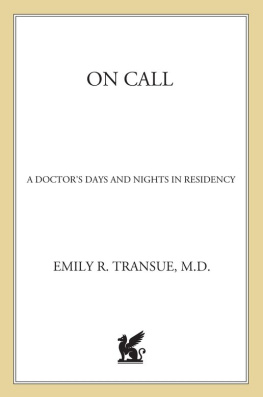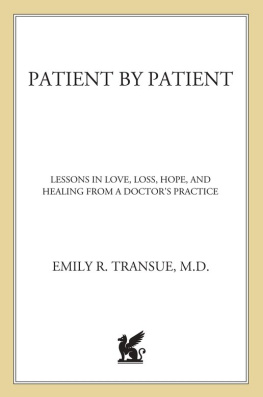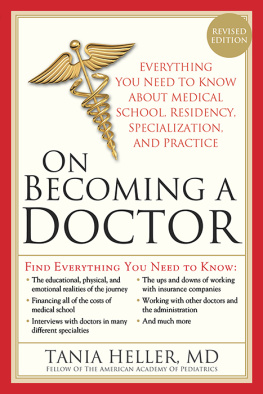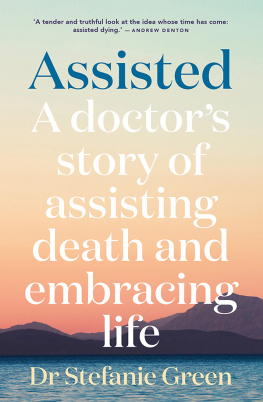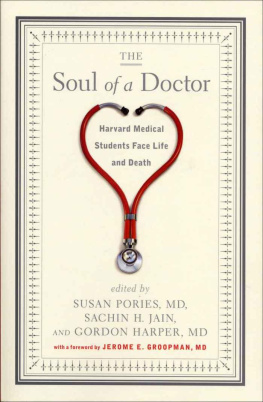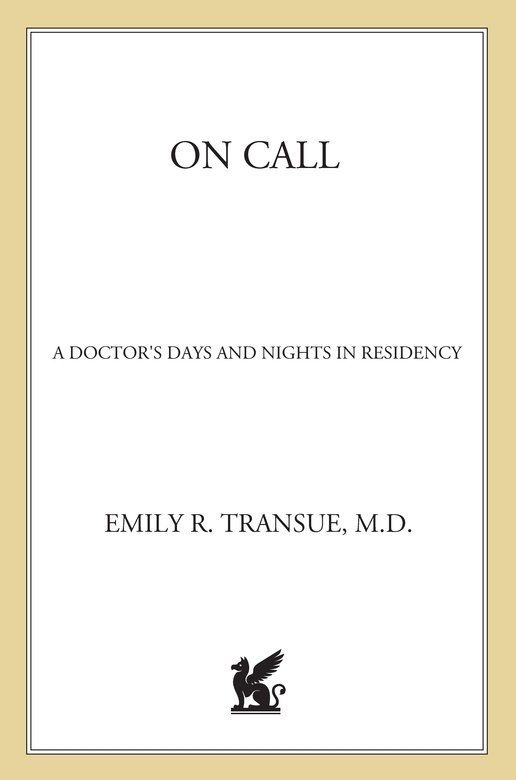I would like to acknowledge the following, without whom this book would never have come into existence: Chris Pepin, who made residency bearableheres to never having to do it again. Blair Brooks, who started all this by reading an e-mail-I promise Ill read aloud more slowly this time around. My wonderful agent, Joan Raines, and her partner, Theron Raines, for believing in me and in the book. Diane Reverand, Gina Scarpa, and everyone at St. Martins Press. Roxanne Young at JAMA, for crucial early support and encouragement. Dana Grossman and the staff of Dartmouth Medicine, fabulous people and staunch supporters of my writing all alongthey first published several of these stories, and were most generous in releasing Web rights. Doug Paauw, Erika Goldstein, Chris Surawicz, and Connie Celum, who have continued to nurture both my literary and my medical career. Alison Samitt, Shala Erlich, Dennis Rivet, and Ellen Gerety, wonderful readers as well as friends. Kit Transue, John Straub, and William and Monique Transue, the most supportive family anyone could have. My father, Jacques Transue, who will always be part of everything I do; he would have been proud to see this published. Chris Knight, for nursing me through the birth pains of this book, doing everything from copy-editing to technical support to reassembling the despairing author whenever she fell apart. Most of all, my patients, for teaching me and sharing their stories with me. This is their book.
ABG: arterial blood gas; test run on blood drawn from an artery (typically the radial artery in the wrist) to determine oxygen and carbon dioxide levels
ADENOCARCINOMA: cancer of glandular tissue
A-FIB: atrial fibrillation ( see )
ALBUTEROL: medication used in aerosolized form to open bronchial airways in asthma or other lung disease
A-LINE: arterial catheter, typically placed in radial artery for continual monitoring of blood pressure and access to arterial blood for oxygen and carbon dioxide monitoring
AMPHO: amphoterocin ( see )
AMPHOTEROCIN: antifungal medication used for severe fungal infections
AMYLOIDOSIS: poorly understood disorder in which abnormal protein is deposited in multiple organs causing damage to blood vessels and other tissues
ANALGESIC: pain medication
ANGIOGRAM: image of a blood vessel created by shooting radioactive dye into the vessel through a directed catheter, often inserted into an artery in the groin. Commonly done on the blood vessels of the heart (coronary angiogram) or brain (cerebral angiogram)
ANTIBODY: immune molecule that recognizes and attacks a foreign protein (antigen)
ANTIGEN: fragment of a protein recognized by the immune system
ANTIRETROVIRAL: medication used against a class of viruses called retroviruses, including HIV and hepatitis B
ANTIVIRAL: medication used against viruses (HIV, herpes, etc.)
ASCITES: excessive fluid in the abdominal cavity, seen in liver disease and certain cancers and infections
ASCITIC: having to do with ascites ( see )
ASPERGILLOSIS: infection with the aspergillus fungus
ASPERGILLUS: a type of invasive fungal infection
ASYSTOLE: heart stoppage with absence of electrical activity; flatline
ATIVAN: common sedative medication
ATRIAL FIBRILLATION (A-FIB): irregular heartbeat caused by erratic contraction of the atria, the small chambers of the heart; the ventricles (large chambers) contract normally, so, unlike ventricular fibrillation (v-fib), this is not necessarily life threatening
ATTENDING: physician who has completed training in a specialty; used in an academic setting to refer to doctors who are supervising those still in training
BENZODIAZEPENE: common class of sedative medication including Valium, Xanax, and Ativan
BIOPSY: piece of tissue removed from the body for microscopic analysis
BRADY: bradycardia ( see ) ; also used as a verb, slowing of the heart rate
BRADYCARDIA: abnormally slow heart rate
BRONCHOSCOPY: test in which a small flexible tube is inserted through the nose or mouth into the trachea to allow direct examination and biopsies of the airways
BRONCHOSPASM: closure or tightening of the airways (bronchi), as in asthma or COPD ( see )
CACHECTIC: excessively thin
CANNULA: stiff catheter ( see ) , often used as a guide for placing a longer, softer catheter into a vein
CARCINOID: a rare type of tumor, generally found in the lung or gas-trointenstinal tract, that secretes serotonin and related hormones, causing diffuse symptoms including flushing, high blood pressure, and diarrhea
CARCINOMA: cancerous tissue
CATHETER: tube placed into a body space, including the bladder (Foley catheter), vein, spinal column, etc.
cc: milliliter
CCU: Cardiac Intensive Care Unit
CELLULITIS: infection of the deep layers of the skin
CENTRAL LINE: large IV catheter placed into one of the large veins near the heart, commonly the jugular or subclavian vein in the neck or the femoral vein in the groin. Allows rapid infusion of drugs, fluid, or blood, as well as monitoring of pressure in the veins
CEPHALOSPORIN: a class of antibiotic
CNA: certified nursing assistant
COAGULATION: clotting of the blood
CODE: the process of attempting to revive a patient after sudden death (cardiopulmonary arrest) occurs, following the protocols of advanced cardiac life support (ACLS). As a verb, to code, either (for a patient) to die suddenly, or (for a doctor) to attempt resuscitation on a patient
CODE STATUS: decision about what should be done in the event of sudden death; typically either full code (all measures should be taken to attempt to revive the patient) or DNAR (do not attempt resuscitation)
COPD: chronic obstructive pulmonary disease; lung diseases generally caused by long-term smoking, including chronic bronchitis and emphysema
CORONARY: having to do with the blood vessels to the heart
CPR: cardiopulmonary resuscitation
CRIXIVAN: common medication for HIV
CRYPTOCOCCUS: type of invasive fungal infection
CSF: cerebrospinal fluid; fluid encasing the brain and spinal cord, typically sampled via a lumbar puncture or spinal tap, a hollow needle placed through the low back into the spinal column
CT SCAN: computed tomography scan; also called CAT (computed axial tomography); special form of X-ray that uses computer technology to create cross-sectional images (slices) of the area being scanned
CVA: cerebrovascular accident; stroke
DECEREBRATE POSTURE: body posture indicating loss of function of the higher brain (cerebrum)
DETOX: detoxification program, aimed at eliminating physical dependenceon alcohol or drugs (constrast to rehab, which addresses both physical and psychological addiction)
DIC: disseminated intravascular coagulation, disorder in which blood clots form in blood vessels throughout the body, paradoxically associated with abnormal bleeding as well; occurs in severe infections and other disorders; usually life threatening
DNAR: do not attempt resuscitation; decision not to attempt to restart the heart and lungs in the event of sudden death
DNR: DNAR (variant)
EMD: electromechanical dissociation; heart stoppage with normal electrical activity but no heart muscle response; also called PEA, pulseless electrical activity
ENCEPHALOPATHY: dysfunction of the brain

